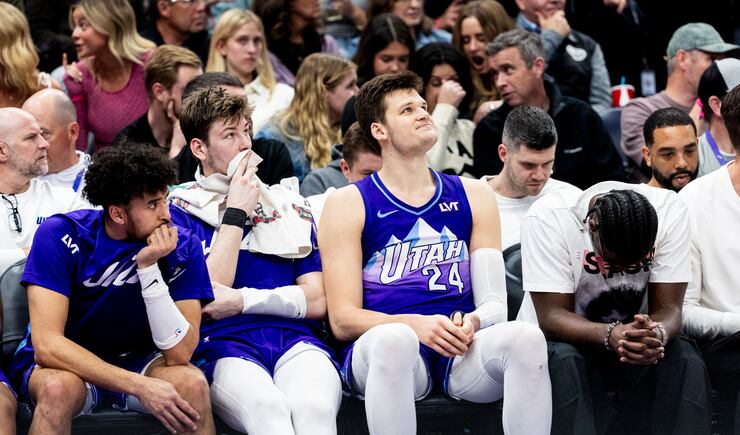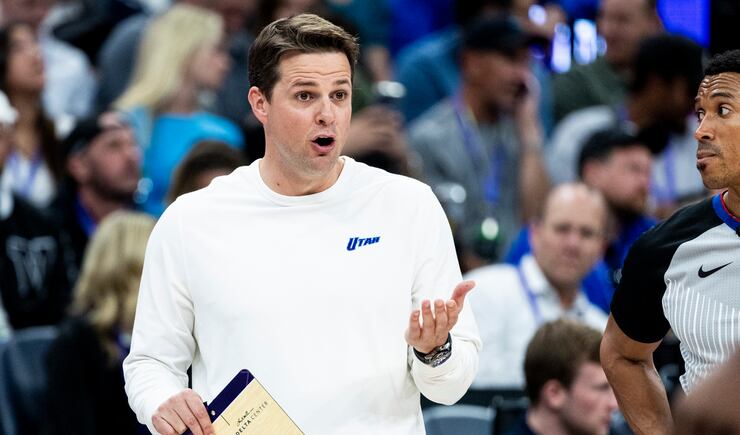The top government employees at the Utah Capitol earn more than their counterparts in some of the country’s most populous states, according to publicly available salary information.
The chiefs of staff for the Utah Governor’s Office, Utah Senate and Utah House all made over $300,000 in 2024, with each position receiving a 40% raise over the previous two or three years, according to data that is accessible through the Utah state auditor’s Transparent Utah website.
Legislative leadership said the salaries and raises are justified because Utah’s part-time Legislature and its relatively small number of legislative staff require the people in full-time positions to cover a variety of responsibilities, making the jobs demanding and difficult to fill in the state’s tight labor market.
Here’s what the governor’s top staff makes
Jon Pierpont, who Gov. Spencer Cox brought on as chief of staff in 2021, received a salary of nearly $338,000 in 2024, not including benefits, which add nearly $123,600 to last year’s total.
Cox earned just over $182,200 that same year, with an additional $62,800 in benefits. It is not unusual for a governor’s chief of staff to make more than a governor. This was the case in most of the states reviewed by the Deseret News.
Similar chief-of-staff positions for governors in other states with easily accessible government employee data all made less:
-
-
-
Connecticut: $240,710 (2025)
-
-
New York: $214,322 (2023)
-
-
-
-
Massachusetts: $185,285 (2024)
*Estimate based on hourly rate.
Of these states, Utah has one of the smallest populations, at 3.5 million, compared to 31.3 million in Texas, 23.4 million in Florida, 19.9 million in New York, 11.9 million in Ohio, 7.1 million in Massachusetts, 6.9 million in Indiana, 3.7 million in Connecticut and 2 million in Idaho.
“The context matters: He not only leads the Governor’s Office as Chief of Staff, but also serves as Chief Operating Officer over 20 state agencies and 22,000 employees — overseeing a budget and workforce larger than those managed by most tech CEOs,” said Rob Carroll, senior adviser for communications to Cox, in a statement.
Utah state executive offices are each headed by a director, a commissioner or board members who report to Pierpont. Most of these leaders belong to Cox’s Cabinet and earn between $200,000-250,000 a year.
Before joining the Governor’s Office, Pierpont, who attended the University of Utah, worked as the executive director of Utah’s Department of Workforce Services for eight years under former Gov. Gary Herbert.
Pierpont’s annual salary doubled during his first year as chief of staff from $120,574 in 2021 to $242,572 in 2022, before increasing by $50,000 in 2023 and $40,000 in 2024, constituting a nearly 40% raise over those two years.
Here’s what lawmakers’ top staff make
The chiefs of staff in Utah’s state House and Senate have also seen regular salary increases. While the Legislature appropriates funding for government agencies, each office determines employee salaries. The Senate president and House speaker determine the salary of their respective chief of staff.
Senate chief of staff Mark Thomas’ salary has increased from just under $148,000 in 2019 to more than $314,200 in 2024, including a 20.5% raise from 2023 to 2024. These totals do not include benefits which made up another $117,300 in 2024.
Here’s how that salary compares to similar positions in other states:
-
-
-
-
Connecticut: $226,425 (2025)
-
-
-
Massachusetts: $187,537 (2024)
-
New York: $175,994 (2023)
-
*Estimate based on hourly rate.
Utah’s Senate chief of staff oversees all Senate employees and works with legislative leadership to “manage the day-to-day operations of the Senate” and to coordinate with the House and Governor’s Office, according to a statement from the state Senate majority.
Thomas, who studied political science at the University of Utah, came to his Senate position from the Lieutenant Governor’s Office, where he served as the state’s elections director under then-Lt. Gov. Cox.
Likewise, over the past four years, House chief of staff Abby Osborne’s salary has increased from around $183,800 in 2020 to nearly $315,200 in 2024, with a 15% raise from the previous year. This does not include the $104,800 she also received in benefits.
Here’s how that salary compares to similar positions in other states:
-
-
-
Connecticut: $219,115 (2025)
-
-
-
New York: $184,886 (2023)
-
-
Massachusetts: $174,983 (2024)
-
*Estimate based on hourly rate.
Osborne, who studied business management at Montana Technological University, previously worked as the senior vice president of public policy and government relations for the Salt Lake Chamber.
While it comes out near the top in terms of chief of staff salaries, Utah has a shorter legislative session than any of the other states.
In 2025, Utah’s first-in-the-nation session was 45 days long. Meanwhile, Florida’s will be 60 days, Idaho’s will be 95 days, Indiana’s will be 112, Texas’ will be 140, Connecticut’s will be 148 days and Ohio’s, Massachusetts’ and New York’s are year-round.
As a part-time citizen legislature, Utah employs fewer full-time staff than most states, potentially putting more responsibility on the chiefs of staff to handle a greater variety of jobs and to manage some of the workload of the Senate president and House speaker during the interim.
Here are the nine states considered above, ranked by the number of full-time legislative staff in 2021, with the number of part-time employees hired during the session in parenthesis:
-
-
-
-
-
-
-
-
-
For fiscal year 2021, Utah spent less on legislative branch expenditures than 41 other states, ranking fifth in the country when comparing legislative costs to Utah’s overall budget, according to a report from the National Conference of State Legislatures.
Since 2004, Utah’s population has increased by 45% but the number of state employees has increased by just 7%, according to the Governor’s Office.
Legislative leadership react
A joint statement from Senate President Stuart Adams, R-Layton, and House Speaker Mike Schultz, R-Hooper, said that as one of the fastest-growing and best-run states in the nation, Utah requires “the hard work, expertise and dedication of highly qualified public servants.”
“Staff who manage operations, advise decision-makers and oversee a wide range of urgent, sensitive and complex issues are indispensable,” the statement said. “Utah’s part-time legislature is backed by a full-time staff, creating an efficient structure that enables lawmakers to concentrate on serving the public while relying on a dedicated team to provide ongoing support. This requires long hours and high levels of dedication. That’s why it’s not just important but essential to have the right people in key positions.”
Utah’s citizen Legislature pays part-time lawmakers $293.55 per day for all authorized legislative days, for a total of $13,200 delivered as a lump sum payment before the beginning of the session, according to a 2024 report.
Lawmakers may receive reimbursements for travel, meals and lodging and are also entitled to retirement benefits and a health care insurance package. Legislative leadership also receive a bonus of $3,000-5,000 a session depending on their position, with the average legislator making nearly $37,200 a session.
Schultz and Adams in their statement said that the compensation appropriated for their top aides is “comparable with wages for city, county and state level executive employees.”
“We deeply value the contributions of all our state employees, and we believe that investing in top-tier talent is critical to safeguarding Utah’s long-term success and ensuring the sustainability of our government,” the statement said.
In the upcoming year, Salt Lake City Mayor Erin Mendenhall is estimated to make just under $189,300, while her chief of staff, Rachel Otto, will make over $231,000, not including benefits.
Salt Lake County Mayor Jenny Wilson made just over $191,600 in 2024, while her chief of staff, Andrew Roberts, made over $151,400. Meanwhile, Provo City Mayor Michelle Kaufusi made $145,000 and her deputy, Isaac Paxman, made just over $149,300.
Keeping up in a competitive market
Last month, Senate Budget Chairman Jerry Stevenson, R-Layton, said that lawmakers approve higher salaries for their staff “to keep everyone up into what we call ‘market.‘”
Senate Minority Leader Luz Escamilla, D-Salt Lake City, defended the salaries Utah pays. Top legislative aides are “very unique positions,” she said.
Adams said it comes down to supply and demand. It is hard to hire qualified attorneys in Utah’s tight labor market, Adams said, suggesting that salary surveys had showed a need for raises.
“We’ve either got to pay our people competitively or we’re not going to have people. And that’s probably the bottom line,” Adams said.
In several analyses, Utah ranks around the middle of the pack in terms of cost of living, with Forbes naming it the 20th most expensive place to live in the country, U.S News & World Report naming it No. 25 and World Population Review putting it at No. 17.
On housing affordability, however, Utah ranks among the very worst. World Population Review places the state sixth highest on a scale of median home value, and ATTOM data puts it at No. 7, with a median home price of over $550,000.
Utah is tied in seventh place for lowest unemployment rate in the country.



































